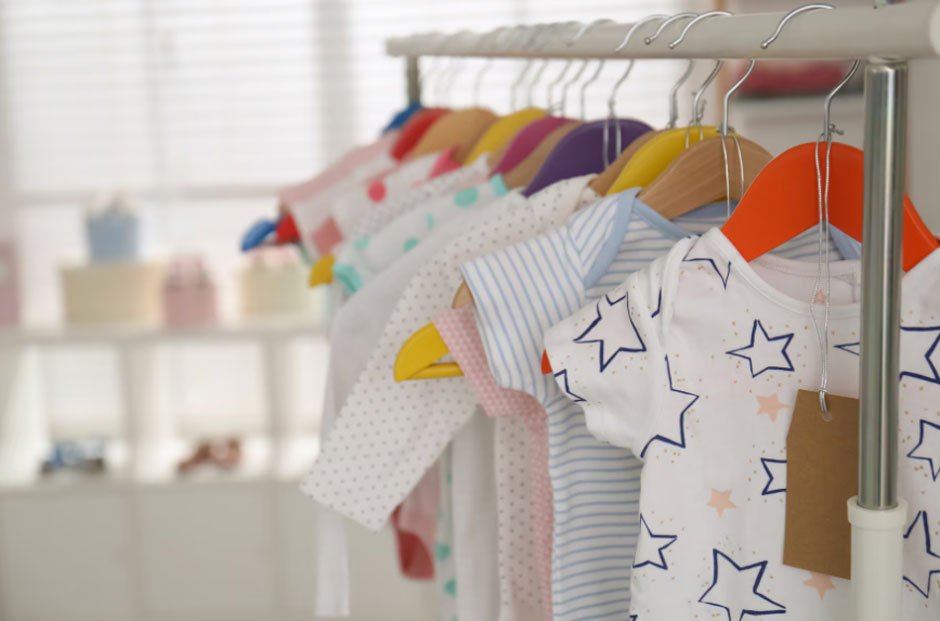Navigating the world of baby clothing can be a challenge for new parents, grandparents, and store owners alike. With different sizing systems in different countries, fluctuating growth rates, and an endless array of adorable outfits, it’s easy to feel overwhelmed.
This comprehensive guide aims to demystify baby clothing sizes, helping you make informed decisions for your little one.
The Importance of Understanding Baby Clothing Sizes
Understanding baby clothing sizes is crucial for several reasons. First and foremost, it ensures that your baby is comfortable and can move freely. Ill-fitting clothes (and shoes) can cause irritation and even restrict movement, which is not ideal for a growing infant.
As babies grow rapidly, their clothing needs evolve just as quickly. Understanding the importance of accurate sizing is vital not only for comfort but also for safety. Clothes that are too tight can restrict circulation and limit mobility, which is particularly concerning during critical developmental stages when infants are learning to crawl, stand, and walk. On the other hand, overly large garments may pose a tripping hazard or leave excess fabric that can get caught in toys or furniture.
Moreover, selecting the right sizes at different growth milestones can help parents avoid the stress of frequent shopping trips or the hassle of dealing with clothing that no longer fits. Parents should consider factors such as seasonality and fabric flexibility, ensuring that each piece is suitable for the baby’s current stage and environment. By monitoring their child’s growth and choosing appropriately sized clothing, parents can foster a sense of ease and confidence as their little ones explore the world around them.
Additionally, knowing the correct size helps avoid unnecessary returns and exchanges, saving both time and money.
Finally, for e-commerce store owners, accurate sizing information can significantly enhance customer satisfaction and reduce return rates.
Overview of the Different Sizing Systems Used Globally
Baby clothing sizes vary from country to country, making it essential to understand the different systems used globally.
In the United States, sizes are typically labelled by age, such as 0-3 months or 3-6 months. However, this can be misleading as babies grow at different rates.
European sizes, on the other hand, are based on the baby’s length in centimetres, offering a more precise measurement.
Asian countries like Japan also use length-based systems but may have slight variations.
Knowing these differences can help you make better choices, especially when shopping from international brands.
Detailed Breakdown of How to Measure a Baby for Clothing
Measuring your baby accurately is the first step in finding the right clothing size. You’ll need a soft measuring tape for this task.
Step-by-Step Guide to Measuring Your Baby for Clothing
1.Gather Your Materials:
- Obtain a soft measuring tape and have your baby in a comfortable position, preferably lying down or standing upright if they can.
2.Measure Height:
- Ensure the baby is straight and flat on their back or standing.
- Use the measuring tape to measure from the top of their head to the bottom of their feet.
- Record this measurement.
3.Measure Chest Circumference:
- Wrap the measuring tape around the fullest part of the baby’s chest.
- Ensure the tape is snug but not too tight.
- Record this measurement.
4.Measure Waist Circumference:
- Find the natural waistline, which is usually located just above the belly button.
- Wrap the tape around the waist and ensure it is level and snug.
- Record this measurement.
5.Measure Hip Circumference:
- Measure around the widest part of the baby’s hips.
- Ensure the tape is level and snug.
- Record this measurement.
6.Compare to Size Chart:
- Refer to the size chart provided by the specific clothing brand and find the corresponding sizes based on the measurements taken.
- Select the size that best matches the measurements to ensure a comfortable fit.
Tips for Navigating Online Baby Clothing Shopping with Size Charts
Shopping for baby clothes online can be convenient but challenging if you’re unsure about sizing. Most online retailers provide size charts, which are invaluable tools. Always refer to the size chart specific to the brand you’re purchasing from, as sizing can vary. Pay attention to the fabric and stretchiness of the material, as these factors can also affect the fit.
Reading customer reviews can offer additional insights into the sizing accuracy and quality of the clothes. Make it a habit to double-check the return policy before making a purchase, just in case the size isn’t quite right.
Common Pitfalls to Avoid When Choosing Baby Clothing Sizes
Choosing baby clothing sizes can be tricky, and there are common pitfalls to avoid. One mistake is buying too far ahead. While it might be tempting to purchase clothes for when your baby is older, growth spurts can be unpredictable. Another pitfall is ignoring the fabric type. Some materials shrink after washing, so it’s essential to consider this when choosing a size. Lastly, don’t forget that different brands have different sizing standards, so always refer to the brand-specific size chart.
Insights into the Future of Baby Clothing Sizes and Technology
The future of baby clothing sizes is likely to be influenced by technology. Innovations like smart fabrics and adjustable clothing are already making their way into the market. These advancements aim to provide a perfect fit for a longer period, reducing the need for frequent replacements. Additionally, augmented reality (AR) is being explored for virtual try-ons, allowing parents to see how an outfit will fit their baby before making a purchase. These technological advancements promise to make shopping for baby clothes more convenient and accurate.
Conclusion
Getting baby clothing sizes right is essential for comfort, convenience, and satisfaction. By understanding the different sizing systems, measuring your baby accurately, and navigating online shopping effectively, you can ensure that your little one is always comfy and stylish. For e-commerce store owners, providing detailed and accurate sizing information can significantly enhance customer satisfaction and reduce return rates.
FAQs
What is the most accurate way to measure my baby for clothing?
The most accurate way to measure your baby is by using a soft measuring tape to measure their height, chest, waist, and hips. Compare these measurements to the size chart provided by the clothing brand.
How often should I measure my baby for new clothes?
Babies grow rapidly, so it’s a good idea to measure them every few months to ensure their clothes fit comfortably.
Do all brands use the same sizing system?
No, different brands use different sizing systems. Always refer to the size chart specific to the brand you’re purchasing from.
Are there any signs that my baby’s clothes are too small?
Yes, signs include difficulty fastening buttons, marks on the skin from tight clothing, and restricted movement. If you notice any of these signs, it’s time to size up.
Can I find size charts for international brands?
Most international brands provide size charts on their websites. It’s essential to refer to these charts, especially when buying from different countries, to ensure the best fit.







